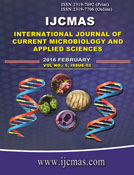


 National Academy of Agricultural Sciences (NAAS)
National Academy of Agricultural Sciences (NAAS)

|
PRINT ISSN : 2319-7692
Online ISSN : 2319-7706 Issues : 12 per year Publisher : Excellent Publishers Email : editorijcmas@gmail.com / submit@ijcmas.com Editor-in-chief: Dr.M.Prakash Index Copernicus ICV 2018: 95.39 NAAS RATING 2020: 5.38 |
Amputation of limbs has a determined and huge cost to healthcare system and associated with increasing the hospitalization time. Amputation of limb is one of the scariest and most expensive surgeries both materially and emotionally considered for patients. Amputation is meant to cut off parts of the body due to trauma, gangrene and malignancies, vascular and congenital problems. Meanwhile, vascular disease and Diabetes in the head of them, has a significant impact in increasing amputation rate and its disabilities. This study is a retrospective cross - sectional study that after the adoption of the Research Council of faculty medicine of Tabriz Islamic Azad University begun to work. Data from this study during the study period (10 months) were collect from the entire patients that were amputation cases in the Imam Reza (AS) hospital. All information including age, sex, length of hospitalization, number of hospitalization, type of amputation, and cause of amputation were recorded and then by the SPSS software were analyzed. Results were presented in tables and graphs of frequency and for descriptive characteristics of the P-Value less than 0.05 was considered significant. In this study, all the patients from March 2011 to February 2014 that had amputated were examined that in total, 268 cases of amputation was carried out that of these 205 person were male (76.49%) and 63 person were female (23.51%).Rate of under 15 years patients were 20 person (7.46%), 15-60 years were 130 person (48.5%) and people over 60 years were 118 person (44.4%). The most common cause of amputation is vascular with 162 cases (60.44%) and other causes are Trauma 47cases (17.53%),congenital 26 cases(9.7%),infection 26 cases(9.7%) and malignancies 7 cases (2.63%). Congenital causes were18 cases of Polydactyly, an obstetric complication due to constriction ring and a case of bone hypertrophy an 6 cases of congenital malformation. The study showed that a high percentage of limb amputation are due to vascular causes, especially diabetes and its complications that Most of the patients in the people that make up society groups are involved with economic issues of family and society that shows the necessity of more care planning to reduce complications and risk factors for vascular disease and trauma the leading causes of amputation.
 |
 |
 |
 |
 |